Former WRF Innovation Fellows
 RALPH CACHO, PhD – Collaborating PI: Michael Gelb, Department of Chemistry
RALPH CACHO, PhD – Collaborating PI: Michael Gelb, Department of Chemistry
The anticancer agents salinosporamide A and rebeccamycin, the antifungal griseofulvin and the antibiotic vancomycin all contain carbon-halogen bonds. The presence of the halogen atom in these compounds is
vital to the activity of the respective molecules. A lack of specificity and regioselectivity (a process that favors bond formation at a particular atom) has hampered classical synthetic chemistry methods for carbon-halogen bond formation. But enzymes evolved a variety of elegant mechanisms to catalyze this synthetically challenging reaction. Hence novel methods for the introduction of carbon-halogen bonds in advanced synthetic or biosynthetic intermediate with complex molecular scaffolds can be developed by engineering these halogenating enzymes.
My project aims to apply computational protein design to redesign a chlorinase enzyme with a modified substrate scope. To demonstrate the potential of computational protein design to efficiently change the substrate scope of the enzyme, I will design the chlorinase to catalyze the conversion of dechlorogriseofulvin to griseofulvin. Griseofulvin is an antifungal compound used in the treatment of skin and scalp infections caused by dermatophytes like tinea capitis and tinea pedis. While previous engineering approaches have been performed on chlorinase enzymes, previous examples use indole-containing substrates (such as tryptamine) or aryl rings with nitrogen substituents (such anthranilic acid or kyneurine). While these examples highlight the plasticity of the substrate scopes of this class of enzymes, they also highlight the deficiencies of the current approaches used to modify the specificity of flavin-dependent chlorinases. My project aims to supplement these current methods with computational design by targeting a reaction involved in the synthesis of a medically relevant compound.
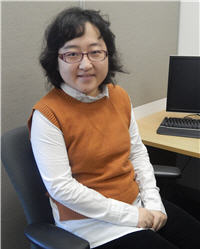 QIAN CONG, PhD – Collaborating PI: Harmit Malik, Fred Hutchinson Cancer Research Center
QIAN CONG, PhD – Collaborating PI: Harmit Malik, Fred Hutchinson Cancer Research Center
Similarities between biological systems are frequently the result of descent from the common ancestor, and variations modulate the properties without disrupting shared functionalities. The centerpiece of biological enquiry, the function, is a consequence of interactions between molecules, cells and organisms. Interactions in an evolvable system are shaped by coevolution at all levels, within and between organisms. Imprints of coevolution can be deciphered by the analysis of co-variation in large datasets and used to predict functional interactions, suggest hypotheses for experimentation, and streamline discovery process.
My research program will focus on coevolution in biological systems and harvesting coevolutionary information from large genomic datasets to predict functional properties. First, I will develop computational methods to deduce interactions between proteins, model spatial structures of macromolecular complexes and apply them to medically important systems. Next, I will analyze coevolution at the level of cells and organisms to address the question about genetic determinants of host-pathogen specificity. Finally, I will use coevolutionary considerations to study epistasis and complex traits with the emphasis on non-monogenic diseases.
I graduated from Peking University in Biological Sciences and got my Ph. D. in Molecular Biophysics from the University of Texas Southwestern Medical Center in Dallas, TX. I studied the evolution of protein structures, developed methods to assess structure prediction and to facilitate protein sequence analysis, and applied these methods to proteins related to disease. Furthermore, I established experimental and computational pipelines to sequence, assemble, annotate and comparatively analyze eukaryotic genomes using butterflies as model organisms. Broad training in protein bioinformatics and genomics allows me to use integrative approaches that combine knowledge- and data-based computation with experimental validation.
 ALEXIS COURBET, PhD, PharmD – Collaborating PIs: Joshua Smith and Luis Ceze, Computer Science and Engineering
ALEXIS COURBET, PhD, PharmD – Collaborating PIs: Joshua Smith and Luis Ceze, Computer Science and Engineering
Computers have revolutionized our understanding and relation to the world. Automating the manipulation of information, they transfer human labor to machines and augment human capabilities. While science and engineering have placed increasing demands on computation, miniaturization of silicon-based electronics has been the main driving force behind its enhancement. However, physical limits of CMOS technology are announcing the end of Moore’s law. Further advancing computers to achieve ever-higher densities of useful computational work under specified quantity of time, material, space, energy and cost, remains a critical challenge in the 21st century. Novel approaches relying on biological substrate (i.e. biocomputing) have the potential to outperform conventional silicon. Indeed, living systems are incredibly efficient three dimensional computers capable of solving hard computational problems. Synthetic biologists are thus considering the possibility of engineering computing systems where input, output, software, and hardware are made of biological molecular-scale machinery to store and perform operation on data. This approach holds promising advantages: high density of data storage, massive parallelization and ultra-low power signal processing. Biocomputers are biosynthesized and self-assembling, ensuring a low cost and high scale of production. By nature biocompatible, they could support the monitoring, control and electronic interfacing of biological systems. Therefore, the engineering of biological computing machines could pave the way towards unprecedented scientific opportunities, offering powerful solutions for computer sciences, biotechnology and molecular medicine. Yet, developing functional biocomputers with a scalable architecture remains elusive since tools are lacking to perform precise assembly of biomolecular components at nanoscales.
In this project, we identified proteins as versatile and modular components constituting a vast engineering playground. Proteins self-assemble in a sequence dependent way and are capable of information processing, which we intend to exploit for the rational design of complex three dimensional biocomputers. Although proteins rely on complex folding, allosteric mechanism and interfaces of noncovalent interactions, recent advances in the development of Rosetta software allowed computational design of protein nanomaterials with unprecedented accuracy and design space. De novo protein components can now be generated in silico to self-assemble into specified symmetric scaffolds, which we suggest could support high-order biocomputing architectures. This project thus proposes to harness advances in computational protein design as a systematic methodology to engineer universal nanoscale biocomputers. We propose to investigate how massively parallel computing architectures can be built using self-assembling 3D arrays of protein logic gates, ultimately implementing any given Boolean function. There are two engineering challenges to realizing such systems: first, methods for designing protein nanomachines need to be developed; and second, because of non-conventional substrate, mechanism of information processing, programmability of the computer and interfacing will need to be overcome. The proposed research intends to i) investigate machine architectures and programmability in silico ii) explore design rules, experimental and computational methods for designing 3D self-assembling protein logic gate arrays iii) develop methods for designing digital protein information carriers (i.e. switches). Such computers designed with 10 nm nodes could theoretically accommodate 1015 layered logic gates within a single microliter, while achieving energy requirements orders of magnitude below those of silicon computers.
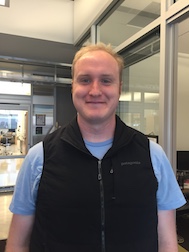 TIMOTHY CRAVEN, PhD – Collaborating PI: Jay Shendure, UW Genome Sciences
TIMOTHY CRAVEN, PhD – Collaborating PI: Jay Shendure, UW Genome Sciences
As a WRF fellow Tim will be working with Jay Shendure (UW Genomics) and David Baker (UW Biochemistry and IPD) to engineer new methods to design synthesize repeat protein architectures and materials of biomedical interest.
Timothy started his scientific career with an emphasis on physical chemistry and obtained a B.Sc. form the College of New Jersey double majoring in Physics and Chemistry. After research stints at the National Aeronautics and Space Administration and the National Institutes of Standards and Technology Tim decided to switch scientific fields and pursue a M.Sc. in Bioinformatics at Georgetown University. After graduating Georgetown and a short research stint at the Food and Drug Administration Tim moved to New York University and completed a PhD in Biology with an emphasis on computational design and synthesis of biomimetic molecular architectures co-advised between the labs of Richard Bonneau (NYU Biology) and Kent Kirshenabum (NYU Chemistry).
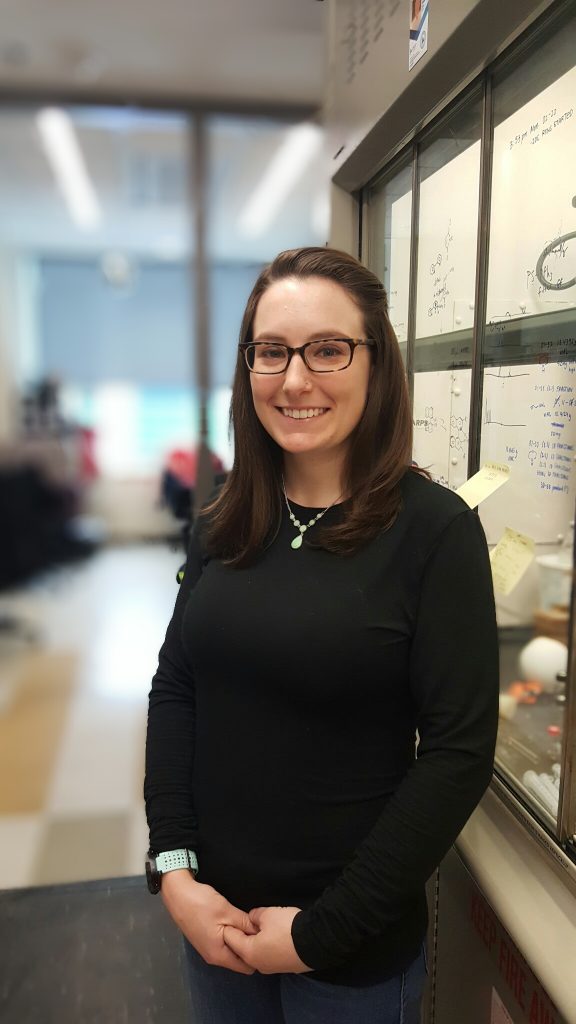
KRISTINE DEIBLER, PhD – Collaborating with Dr. Philip Greenberg, Fred Hutchinson Cancer Research Center
The goal of Kris’s research is to design novel selective peptide-small molecule binders. Peptide binders possess similar advantages compared to proteins and small molecules since they offer specificity by providing greater contact via tertiary structure while also being smaller and more stable.
In particular, she will be working with Prof. David Baker at the University of Washington (de novo design expertise) and Dr. Philip Greenberg at the Fred Hutchinson Cancer Research Center (immunology expertise) to design selective peptide-small molecule binders for specific inhibition of protein tyrosine phosphatases (PTPs) in the context of cancer immunotherapy treatment. Ultimately this will provide access to tools that will allow us to study the unique roles of two similar PTPs (SHP-1/2). Both are potential cancer therapeutic targets via two varying pathways.
Kris graduated with a Bachelor of Science in biochemistry from Duquesne University in Pittsburgh, PA. There she worked on the synthesis and design of heavy metal fluorescent ion sensors in the laboratory of Prof. Partha Basu. She then completed her PhD in chemistry in the laboratory of Prof. Karl Scheidt at Northwestern University. She was awarded the NSF graduate fellowship in 2014. During her doctoral research she developed chemical approaches for studying kinases selectivity, that lead to the development of selective kinase inhibitors for studying chemical pathways.
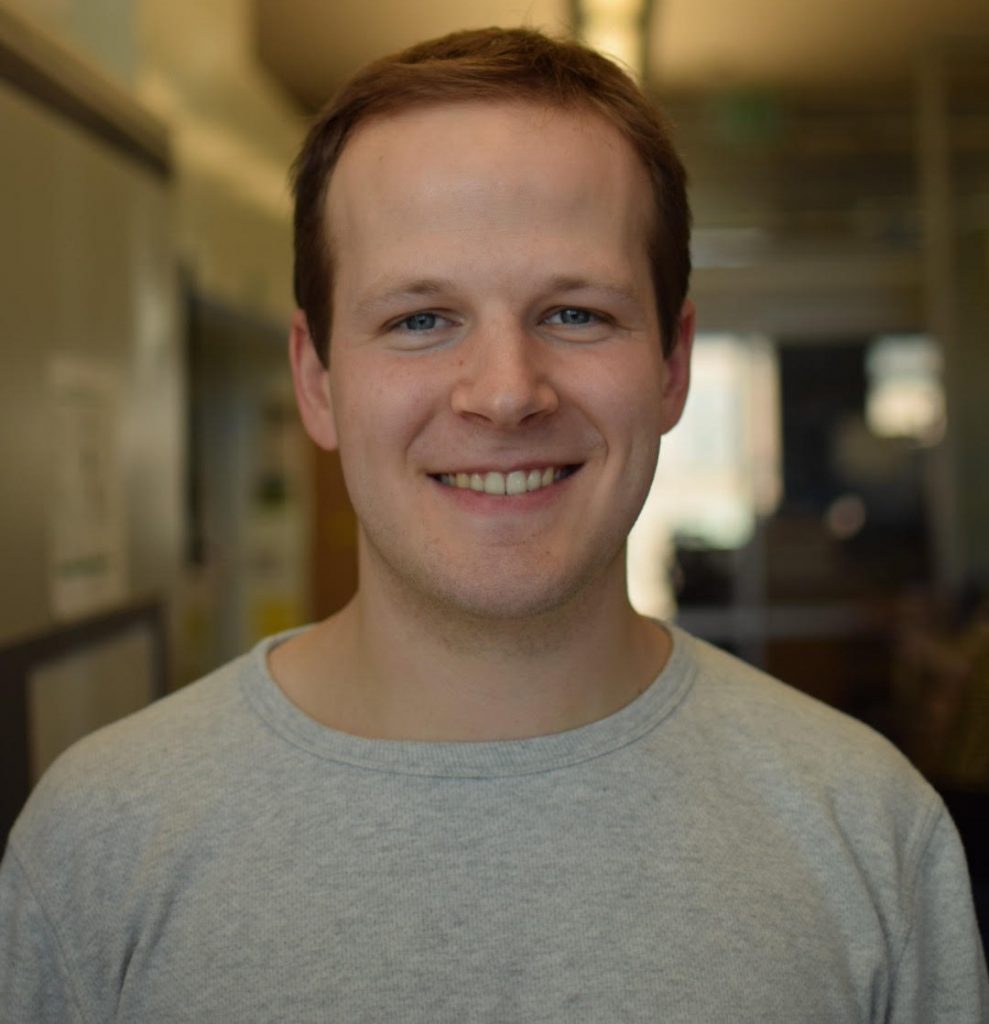
Hugh Haddox, PhD
Advances in computational biology have enabled the field to design proteins with desired structures and functions completely from scratch. As described in the research summaries of other WRF fellows, this technology can be used to tackle a wide variety of challenges ranging from treating cancer to synthesizing biomaterials. However, doing so faces an obstacle: the success rate of protein design is still low, such that designs often fail to take on desired structures and functions when tested in the lab, requiring many to be tested before finding a hit. A major reason for this low success rate is that our models of the physical forces that shape proteins (e.g., van der Waals interactions, hydrogen bonds, etc.) are still imperfect. The goal of my project is to increase the success rate of protein design by increasing the physical accuracy of these models. The Baker lab recently developed a method for measuring the stabilities of thousands of protein designs in a single high-throughput experiment, allowing us to enumerate which designs successfully folded (stable) and which did not (unstable) for an unprecedentedly large number of proteins. I plan to optimize current design models by using such experimental data to retrain them. Specifically, I will first design thousands of proteins tailored to be highly informative for model optimization. Next, I will experimentally quantify each design’s stability. Finally, I will retrain the models to optimally predict these data. I expect the retraining to greatly improve the success rate of protein design, greatly accelerating our ability to use this technology to solve a wide variety of challenges in science and technology.
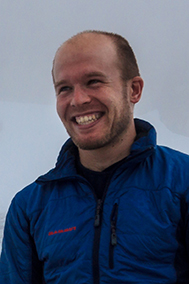
LUKE HELGESON, PhD – Collaborating PI: Trisha Davis, UW Biochemistry
The kinetochore is a ~100 protein molecular machine that connects microtubule ends to chromosomes and harnesses the power of depolymerizing microtubules to segregate chromosomes during cell division. Kinetochores must maintain their connection to chromosomes and microtubule ends while under high tension for a weakening of these connections can halt cell division or promote incorrect chromosome segregation. The kinetochore components that bind microtubules are mostly determined but it is unclear how multiple copies and the structural arrangement of these components can strengthen kinetochore microtubule attachments. Testing the microtubule end attachment strength of kinetochore components at specific binding geometries and stoichiometries will help determine how these attachments bear the forces necessary to regulate and perform chromosome segregation.
As a WRF fellow, Luke will carry out a research plan to test the microtubule end attachment strength of designed kinetochore protein particles. Luke will work with Dr. David Baker (UW Biochemistry and IPD) and Dr. Trisha Davis (UW Biochemistry) to design different protein domains with oligomeric states that are spatially and numerically controlled. These designed protein domains will be attached to kinetochore proteins and purified to yield single particles of kinetochore components at known stoichiometries and geometries. The microtubule end attachment strength of the engineered particles will be tested using optical tweezers microscopy through collaboration with Dr. Charles Asbury (UW Physiology and Biophysics). By using protein design, Luke will be able to directly test how the structure of kinetochore components bound to microtubule ends can modulate the force bearing capabilities of the kinetochore.
Luke graduated with a Bachelor of Science in biochemistry from Iowa State University; where he helped to solve the structure of an Ebola virus protein in the laboratory of Dr. Gaya Amarasinghe. For his graduate work, Luke studied under Dr. Brad Nolen at the University of Oregon. In the Nolen lab, Luke developed single-molecule microscopy experiments to understand how branched actin networks are nucleated and architecturally regulated. For his postdoctoral training, Luke joined the laboratory of Dr. Trisha Davis at the University of Washington where he plans to further his knowledge of cytoskeleton biology and single-molecule microscopy.
 KARLA HERPOLDT, PhD – Collaborating PI: Patrick Stayton, Bioengineering
KARLA HERPOLDT, PhD – Collaborating PI: Patrick Stayton, Bioengineering
Protein-based nanoparticles have been designed and used for a variety of drug-delivery systems. These drug carriers are based on naturally self-assembled protein subunits which form a cage that can be used to trap pharmaceutical compounds. The use of naturally derived proteins offers benefits in terms of their biocompatibility, biodegradability, low toxicity and relative abundance. Despite these advantages, they remain limited in their use, being repurposed from their original biological application. In contrast, the computational design of protein nanomaterials has created the ability to design self-assembling cages which incorporate additional synthetic functionalities into their structure.
Working with the Baker/King labs Karla is working on using computational design to develop ‘smart’ protein cages that exhibit a strong response to environmental pH. In collaboration with the Stayton group these materials can then be loaded with polymer-prodrug carriers. It is hypothesized that the polymer therapeutics can be loaded via pH-dependent assembly of the cages, and subsequently their higher molecular weight will lead to intra-cage retention. In this way she hopes to develop targeted drug delivery vehicles which release their cargo inside the tumor microenvironment, minimizing chemotherapy dosage levels.
Karla obtained her MPhys in physics from the University of Oxford where she studied laser-plasma interactions and space dust formation before discovering a love of biological physics. She then carried out her PhD research in the lab of Prof. Molly Stevens at Imperial College London where her main focus was on the study of phage-derived peptides for use in diagnostics and therapeutics for HIV. She is also interested in peptide-protein interactions and the rational design of protein ligands. During her PhD Karla held a sabbatical fellowship at the UK Parliament’s Office of Science and Technology and was heavily involved with educational outreach.
 PARISA HOSSEINZADEH, PhD – Collaborating PI: Michael Gelb, Chemistry
PARISA HOSSEINZADEH, PhD – Collaborating PI: Michael Gelb, Chemistry
As a WRF fellow, my goal is to develop new computational tools to design cyclic peptides and to use these peptides as specific inhibitors/binders to target enzymes/proteins. Cyclic peptide binders have the advantages of both proteins and small molecules: they can offer specificity through providing more contacts and they are small and usually more stable. Design of cyclic peptides is an exciting new addition to the field of protein design.
In particular, I am working with Dr. David Baker and Dr. Michael Gelb to design new cyclic peptide binders for specific inhibition and study of different members of secreted phospholipase A family of enzymes. These enzymes are known to be important in inflammatory disease states including asthma; however their exact roles remain elusive. While there are small molecule inhibitors for some members of these enzymes, similarly specific small-molecule based inhibitors have not been identified for all members of this family of enzymes hampering their study. This project is aimed to use the designed cyclic peptide to address this issue and provide better understanding of secreted phospholipases.
I was trained as a molecular biologist in my undergrad. My interest in proteins led me to do my graduate research on rational design of metalloproteins in the lab of Dr. Yi Lu. I was mainly focused on altering second shell interactions to tune the activity of proteins. My research provided a general guideline for tuning the redox potential of metal centers.
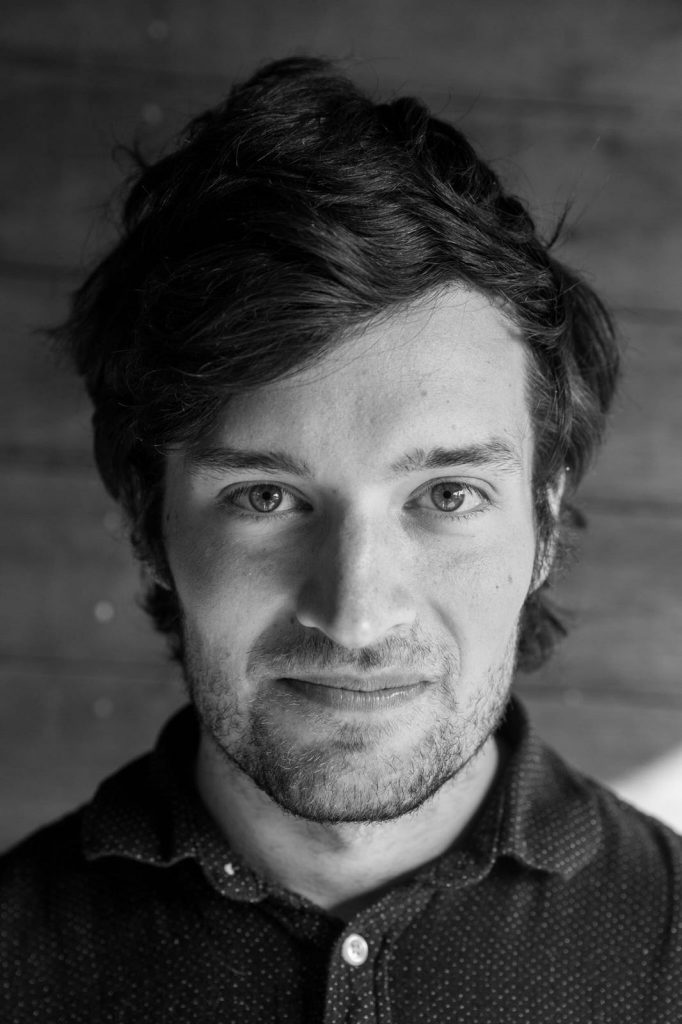
Thaddaus Huber, PhD – Collaborating PI: Jesse Bloom, Fred Hutchinson Cancer Research Center
Creation of a universal flu vaccine that can result in lasting resistance to multiple strains of influenza as well as newly emerging strains is of extraordinary interest. Thaddaus will work under the guidance of Dr. Neil King at the Institute for Protein Design and Jesse Bloom at Fred Hutchinson Cancer Research Center to develop two-component protein nanoparticles displaying flu antigens to induce broadly neutralizing antibodies (bNAbs).
Thaddaus completed his PhD in Chemical and Biological Engineering in the laboratory of Dr. Christopher Snow at Colorado State University. During his doctoral research he developed methods to use a highly porous protein crystal for scaffold assisted crystallography of guest molecules. He is excited for his new opportunity to further develop expertise in protein design and learn cutting-edge methods such as cryo-EM.
 NIHAL KORKMAZ, PhD – Collaborating PI: Dirk Keene, UW Medicine
NIHAL KORKMAZ, PhD – Collaborating PI: Dirk Keene, UW Medicine
Alzheimer’s disease (AD) is a major public health threat, currently afflicting 5.3 million Americans, at an estimated cost of $226 billion per year. This threat is made more urgent by an aging population; the risk of Alzheimer’s disease increases exponentially in those over the age of 65. While basic research has made great strides in understanding the underlying biology, there are no approved treatments to reverse or halt its progression. Like many neurodegenerative disorders, AD involves the accumulation of abnormally folded proteins. The extracellular fibrillar plaques, which are formed by aggregation of misfolded Aβ peptides, are the hallmarks of the disease along with neurofibrillary tangles formed by tau protein. Aβ peptides are 39–43 residue-long peptides derived proteolytically from the transmembrane amyloid precursor protein (APP), generated by β- and γ-secretases. At high (μM) concentrations, the Aβ peptides undergo a large conformational change and aggregate to form toxic oligomers and fibrillar plaques.
Nihal will be working under the guidance of Dr. David Baker and Dr. Dirk Keene to design small, easily produced binding proteins that can sequester the Aβ polypeptide in a monomeric, aggregation-incompetent form. We also aim to design small cyclic peptides which can cap Aβ fibrils and control fibrillar growth.
Nihal received her bachelor’s degree in chemical engineering at Bogazici University in Istanbul, Turkey. After receiving her master’s degree, Nihal’s fascination in biological systems and proteins led her to pursue a graduate degree in biophysics in the lab of Dr. Qiang Cui at the University of Wisconsin—Madison. During her graduate studies, she focused on conformational diversity and structural characterization of large proteins through molecular dynamics simulation and homology modeling techniques in the light of small angle X-ray scattering and X-ray crystallography data.
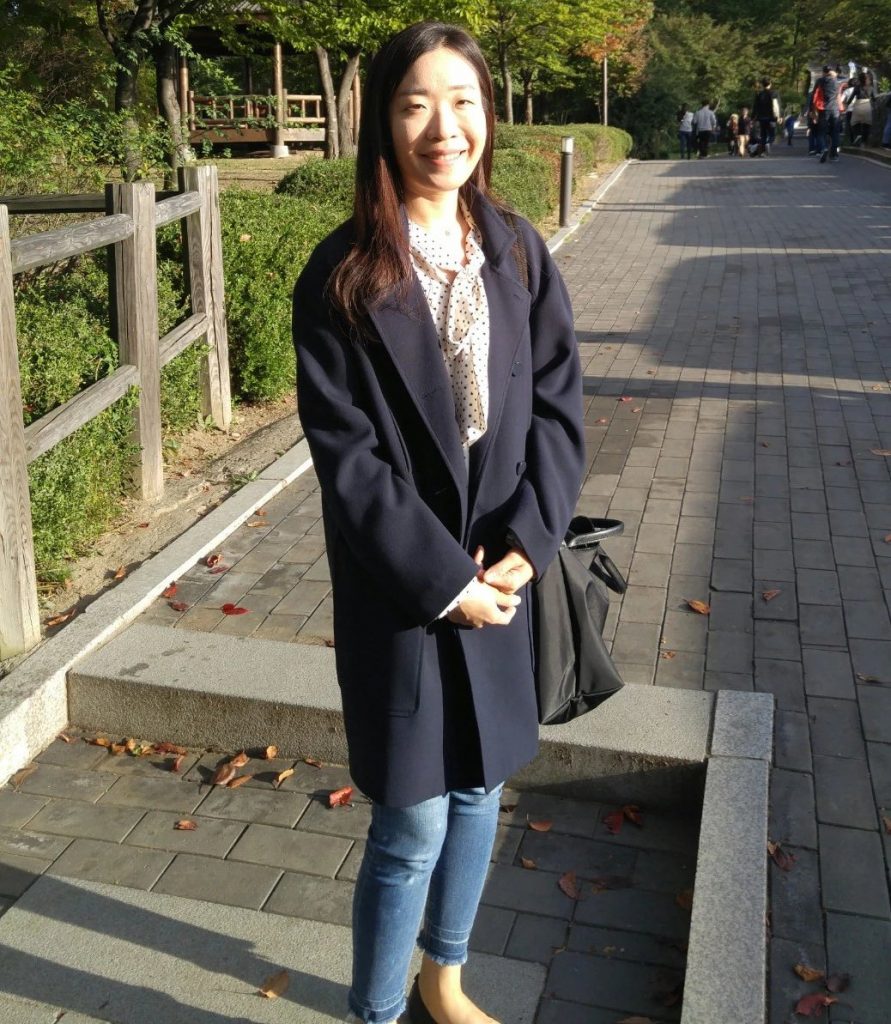
Gyu Rie Lee, PhD – Collaborating PI: Dustin Maly, UW Chemistry
The goal of Gyu Rie’s research is to develop new computational methods for designing proteins which specifically bind to assigned small molecules. She is mostly interested in incorporating ligand flexibility and protein dynamics in binder design. She hopes to increase the efficiency and efficacy of the computational work, which will allow large-scale design of small molecule-binding proteins.
Particularly, as a WRF fellow, Gyu Rie will develop a method for designing a protein switch, which selectively binds to ABL kinase in its ligand-bound state. She will pursue this by working jointly with Dr. David Baker and Dr. Dustin Maly. Molecular switches are developed to sense external signals and regulate the activity of the targeting system. A protein switch which targets ABL kinase bound to its small molecule inhibitor, Gleevec, will be designed in this study. Kinases have multiple binding sites and it has been found that the activity can be controlled more selectively when these sites are targeted together. Gyu Rie will design a switch that targets the secondary binding site of the ABL kinase by considering the conformational change upon ligand binding. The developed molecular switch will be able to control the signaling pathway via ABL kinase. Also, it can be applied to generate a system, which induces dimerization of fusion proteins each linked to the designed protein and the ABL kinase.
Gyu Rie obtained a B.Sc. at Seoul National University majoring in Chemistry Education and minoring in Biological Sciences. She got her Ph.D. in Physical Chemistry also at Seoul National University by doing her graduate studies in the lab of Dr. Chaok Seok. The research she carried out in Dr. Seok’s lab was focused on developing computational methods for refining predicted protein structure models. The developed methods were successfully tested on refinement categories held by recent Critical Assessment of protein Structure Prediction experiments. By studying protein structures, Gyu Rie became more interested in predicting the functions of proteins using the models. She extended her refinement method to predict the ligand-bound G protein-coupled receptor complex structures.
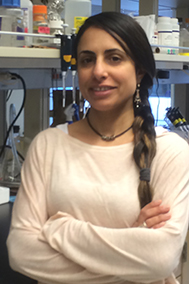
Shiri Levy, PhD. Collaborating PI: Hannele Ruohola-Baker, Biochemistry Department.
Direct reprogramming of the epigenome has tremendous potential to advance applications in disease modeling, drug discovery, and gene and cell therapies. Specifically, histone modifications in promoters and enhancers genes possess distinct features in gain and loss of function. A good example for wide epigenetic repressive marks is in human Embryonic Stem Cells (hESC), as massive gene silencing takes place in early development prior to differentiation. Precise manipulation of histone modification in promoter and / or enhancer areas can therefore lead to cellular reprograming, and encode for lineage specific cell fate.
Together with the Institute of Protein Design (IPD), we apply computational protein design to engineer synthetic, novel proteins that mimic epigenetic modifiers. In order to achieve precise gene target in promoter and /or enhancer areas we incorporate the newly designed proteins with CRISPR-associated null Cas9 nuclease (dCas9). Our goal is to create the ability to reprogram control of gene expression or repression using newly designed epigenetic modifiers while targeting any genomic locus of interest through the simple exchange of the 20-nt targeting sequence of the guide RNA (gRNA). Thus, this technology launches new platform for reprogrammable cell linages as well as introducing control of developmental plasticity of hESC that is largely governed by specific nucleosome architecture.
Shiri received her bachelor’s degree in molecular and cellular biology from the University of Washington in Seattle. After receiving her master’s degree in molecular biology and biochemistry, Shiri focused her graduate studies in exploring the control of gene expression in human mitochondria under the supervision of Prof. Gadi Schuster at the Technion, Israel Institute of Technology. During her PhD studies, Shiri characterized a family of orphan proteins that responsible for digestions of RNA and DNA in both ancient archaea and human mitochondria.
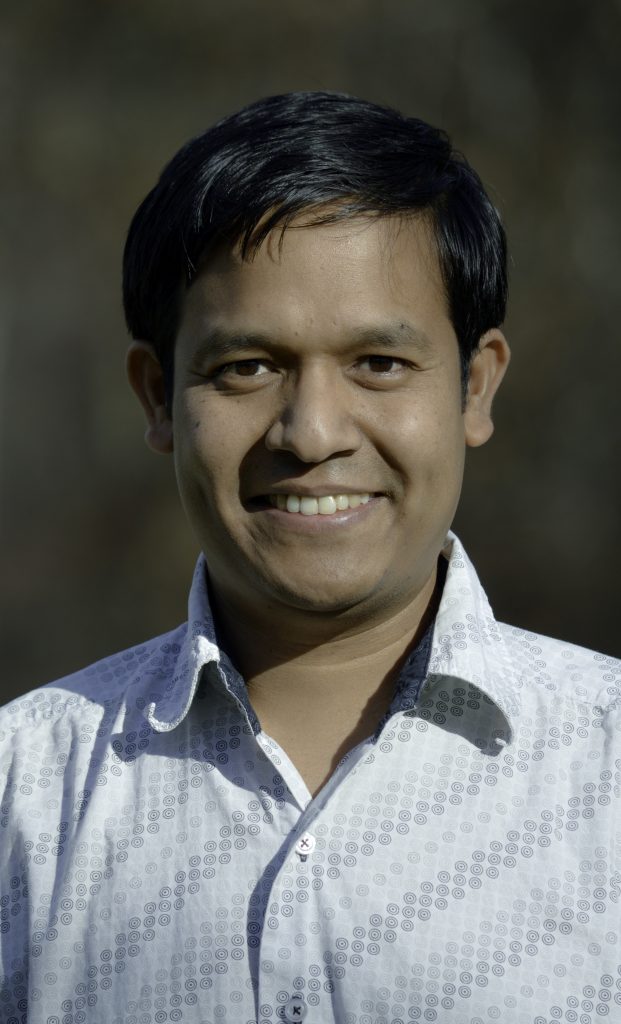 RUBUL MOUT, PhD – Collaborating PI: Jim De Yoreo, Pacific Northwest National Laboratory
RUBUL MOUT, PhD – Collaborating PI: Jim De Yoreo, Pacific Northwest National Laboratory
As a WRF Innovation Fellow at the Institute for Protein Design (IPD), Rubul will work with Prof. David Baker (at IPD) in collaboration with Dr. James J De Yoreo (Pacific Northwest National Laboratory, PNNL). Rubul aims to rebuild some of the large cellular protein machineries, completely from the scratch (de novo), using computational and experimental methods. In one such endeavor, he aims to build a nanodisc-like structure by hierarchically organizing oligomeric protein complexes. Such nanodisc-like protein assemblies are prevalent in many cellular machineries such as immunological synapse, apoptosomes, inflammasomes, and in bacteriorhodopsins, to name a few. He then hopes to use these protein machineries in various applications for remodeling immunological synapse for cancer immunotherapy, intracellular protein networks, and in optogenetics to understand our brain functions. He also aims to build globular protein assembly to mimic/reengineer cellular proteasomes which may be useful to treat neurodegenerative diseases such as Parkinson’s disease.
Rubul was born and grew up in a farmer family in a remote village in the North-East of India. After receiving M.Sc. degree in Chemistry from Gauhati University, Assam, India, he researched at the Tata Institute of Fundamental Research, Mumbai in the field of malarial parasite immunology. He then moved to the University of Massachusetts Amherst to pursue his PhD under Prof. Vincent M. Rotello at the Department of Chemistry. At UMASS, he invented a technology that allowed delivering proteins directly into cell cytosol. This technique was later used to transduce a variety of proteins into mammalian cells including CRISPR/Cas9 systems for gene editing.
Rubul is also the author of two books in his native Assamese language: a collection of short stories and a memoir.
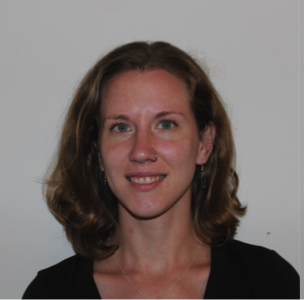
Gretchen Pritchard, PhD
Malaria, caused by infection with Plasmodium parasites, is a major global health burden. B cell expressed antibodies are critical for protective immunity against malaria yet little is known about Plasmodium-specific B cells. Recent studies from the Pepper laboratory have revealed functional heterogeneity among high affinity memory B cells (MBCs) responding to Plasmodium. Remarkably, somatically hypermuated IgM MBCs respond faster to a secondary infection than classically defined IgG MBCs. For the first aim of this project, the signals that lead to the generation of these distinct MBC populations will be elucidated. These studies will inform the second aim of the project, which is to design and engineer immunomodulatory nanoparticles (NPs) in order to drive specific MBC populations. These highly modular NPs are unique as they can be rapidly assembled and are very stable. NPs will express Plasmodium antigens in the context of additional immunomodulatory molecules to induce specific populations of Plasmodium-specific MBCs in mice. The NPs will also be modified to express antigens from Plasmodium species that infect humans in order produce a novel, effective malaria vaccine. These groundbreaking studies have the potential to impact vaccine design to many diseases including HIV and tuberculosis.
After graduating from Oberlin College, Gretchen volunteered as a science teacher in the Peace Corps in Malawi and then worked as a research technician in Dr. Yongwon Choi’s laboratory at the University of Pennsylvania. She then stayed at the University of Pennsylvania where she earned a PhD in Immunology. Under the mentorship of Dr. Christopher Hunter, she examined the role of the Th1-inducing transcription factor T-bet during the immune response to the intracellular parasite Toxoplasma gondii, and uncovered novel functions of this transcription factor.
 DANNY SAHTOE, PhD – Collaborating PI: Andrew Scharenberg, Seattle Children’s Research Institute
DANNY SAHTOE, PhD – Collaborating PI: Andrew Scharenberg, Seattle Children’s Research Institute
Plant pathogens cause significant economic damage since they often inject toxic small molecules and proteins into the cells of agriculturally important plants, such as tomato and bean plants, that can lead to crop loss. One of such pathogens is the bacterium Pseudomonas syringae. In his project*, Danny’s aim will be to introduce novel proteins, that are designed to bind and neutralize a subset of Pseudomonas syringae toxins, into plant cells in order to protect plants from such pathogens. The genetic accessibility of plants and the long standing GMO tradition in plant biotechnology, makes plants suitable candidates for computational protein design approaches. We hope that in the future, our designer proteins will complement the strategies that are currently used to combat plant disease in agriculture.
Danny obtained his PhD in structural biology and biochemistry in Titia Sixma’s lab at the Netherlands Cancer Institute in Amsterdam, the Netherlands. There he worked on elucidating the regulatory mechanisms of a special class of proteases called deubiquitinating enzymes using X-ray crystallography and a variety of biochemical and biophysical techniques.
*Danny Sahtoe is an EMBO long term fellow and was also awarded a WRF innovation fellowship that supports his non-salary research expenses.

FRANZISKA SEEGER, PhD – Collaborating PI: Mohamed Oukka, Seattle Children’s
The ability to therapeutically modulate protein-protein interactions bears enormous potential for the treatment of human diseases. Traditional experimental tools are limited by naturally occurring scaffolds to target proteins central to disease development. Thus, the capability to engineer entirely novel proteins de novo – with a particular structure to fulfill a desired therapeutic function – would be a major advancement in the field of drug development. Franziska is working with David Baker (UW Biochemistry and IPD) and Mohamed Oukka (Seattle Children’s Hospital) to computationally design high-affinity binders to the cytokines IL-23 and IL-17 for the treatment of autoimmune diseases. Autoimmune diseases such as Multiple Sclerosis and Crohn’s Disease have posed a major challenge – elucidating their molecular mechanisms as well as finding effective therapies have been formidable. Current treatments have severe side effects and merely delay disease onset. Small, rationally designed protein therapeutics may have multiple advantages over currently available antibody therapeutics. In this proposal, we aim to design stable and effective IL-17 and IL-23 cytokine binders with minimal immunogenicity and favorable biodistribution to test the role that computationally designed proteins can play as novel therapies.
Franziska has always been fascinated by biochemical pathways and protein-protein interactions and will apply her expertise in protein biochemistry, structural biology, and protein-protein interactions to designing novel interfaces between de novo designed binders and the IL-17 and Il-23 cytokines. In her graduate work with Elsa Garcin at the University of Maryland Baltimore County and John Tainer at Lawrence Berkeley National Lab, Franziska determined the first human heterodimeric wild-type structure of the catalytic domain of soluble Guanylate Cyclase (sGC) – an important drug target for the treatment of cardiovascular diseases. Her work furthered our understanding of sGC heterodimerization and activation and opened new drug discovery routes for targeting the NO–sGC–cGMP pathway in acute heart failure and pulmonary hypertension.
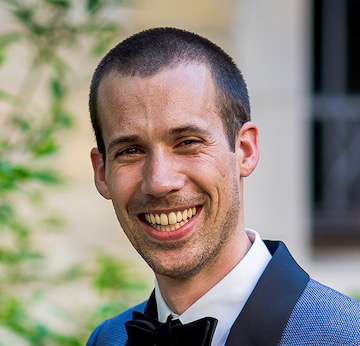
Antibodies mediate immunity to viruses and other pathogens by binding to specific antigenic targets. Our bodies deploy an evolvable arsenal of naïve antibodies capable of responding to diverse antigens. Upon exposure to a new antigen, potent and mature antibodies emerge from this arsenal through the Darwinian process of affinity maturation, consisting of iterative rounds of mutation and selection for improved binding to the antigen. This work seeks to understand the underlying relationship between sequence and function that guides this somatic evolutionary process, by combining antibody lineage reconstruction, high-throughput mutational scanning, and structural modeling approaches. This framework will be applied to an important class of HIV-targeting antibodies that are the subject of ongoing efforts in vaccine design and antiviral therapy.
Tyler obtained a BA in Biology and Biochemistry from Willamette University in Salem, Oregon, where he conducted research with Dr. Chris Smith on the iconic Joshua trees of the Mojave Desert. He combined his interests in evolutionary biology and protein biochemistry during his PhD in Biochemistry and Molecular Biophysics with Dr. Joe Thornton at the University of Chicago, where he used ancestral sequence reconstruction and high-throughput mutational scanning to understand the ancient evolution of protein functions. He seeks to apply this framework, previously used on proteins that existed more than 500 million years ago, to the proteins that evolve in our own bodies over the course of weeks and years during an immune response.
 ZACHARY CROOK, PhD – Collaborating PI: Jim Olson, FHCRC
ZACHARY CROOK, PhD – Collaborating PI: Jim Olson, FHCRC
Zach is interested in novel therapeutic applications for cysteine knotted peptides. While the Olson Lab has a strong interest in their potential uses for cancer treatment, Zach comes from a research background in neurodegeneration, and wishes to investigate the means for getting these natural drug-like peptides across the blood-brain barrier. Efforts towards this will make use of Rosetta and several known structures. Both the knotted peptides that the Olson Lab routinely produces, and several receptor proteins that facilitate transcytosis of natural signaling proteins, will be used to identify potential knotted peptides that can bind these receptors and efficiently transport into the brain. This has the potential to make the blood-brain barrier a little less imposing for therapeutic applications, including neurodegenerative diseases and brain cancer.
Zach attended college at the University of Colorado in Boulder, graduating with honors in Molecular, Cellular, and Developmental Biology. He went right into the PhD program at MIT, where he studied mouse models of Huntington’s Disease under David Housman, and developed assays to rapidly and accurately determine the effect of test therapeutics. The idea of drug design using naturally stable, bioavailable knotted peptides and their potential utility in diseases of the central nervous system drew him to the lab of Jim Olson, where he brings his past knowledge of screening assays in mouse disease models to mix with the biochemical and drug-design expertise of the Olson Lab and collaborators at the FHCRC.
 GERARD DANIEL, PhD – Collaborating PI: Thomas Spiro and Karen Goldberg, UW Chemistry
GERARD DANIEL, PhD – Collaborating PI: Thomas Spiro and Karen Goldberg, UW Chemistry
Naturally occurring metalloproteins, were adaptively evolved to use earth abundant metals as cofactors to effectively tackle their needs and therefore are limited in their function. On the other hand, non-biological late transition metals possess unparalleled potential to catalyze desirable organic transformation for modern synthetic needs. Today, these paradigms can be combined through de novo design of enzyme active sites that incorporate non-biological metals. Gerard will be working along with Dr. Thomas Spiro and Dr. Karen Goldberg to design a metalloenzyme for photocatalytic reduction of CO2 at a (Ru,Zn)-bimetallic active site. Gerard will strategize design techniques to incorporate Ru ion by itself and incorporation of Ru complex to a specific binding pocket in the protein to form the active site. Ultimately, this project will accelerate the merger of the fields of organometallic catalysis and de novo protein design.
Gerard learnt the basics of electronic structure computation while working with Dr. M. Balakrishnarajan during his Master’s degree in Chemistry at Pondicherry University, India. Later, during his Ph. D. at Virginia Commonwealth University under Dr. Nicholas Farrell, he studied novel zinc binding environments in proteins using computational and biophysical techniques. His interests in artificial photosynthesis and the origin of life directed him to his current interest in de novo design of enzymes with non-biological metals for in vitro catalysis. As a WRF Innovation Fellow, he will be working with Dr. Spiro and Dr. Goldberg on the design of a metalloenzyme for photocatalytic reduction of carbon dioxide.
 JASON GILMORE, PhD – Collaborating PI: Michael MacCoss, UW Genome Sciences
JASON GILMORE, PhD – Collaborating PI: Michael MacCoss, UW Genome Sciences
Jason is a 2014 recipient of a WRF Innovation fellowship and will be working jointly with Michael MacCoss (UW Genome Sciences) and David Baker (UW Biochemistry and IPD) to develop high-throughput, highly sensitive screens to accelerate experimental validation for de novo protein design. The first aim of this project will use liquid chromatography coupled tandem mass spectrometry (LC-MS/MS) to simultaneously quantify hundreds of protein designs expressed together in pooled cultures, as opposed to the traditional methods that require individual expression and confirmation of new designs. Additionally, this project will extend software and experimental techniques for MS-based protein chemical crosslinking experiments to rapidly evaluate disulfide linkages in small de novo designed proteins. Together, these mass spectrometry methods will improve the productivity of protein design protocols and accelerate the development of novel protein-based therapeutics.
During his undergraduate summers, Jason worked at the Pacific Northwest National Laboratory in Richland, WA where he helped to implement automated quality control metrics for the proteomics core facility. After graduating from the University of Pennsylvania in 2007, Jason returned to PNNL for one year and wrote a software tool for predicting protein-protein interaction probabilities. His dissertation work at Dartmouth College, in the proteomics laboratory of Dr. Scott Gerber, focused on the detection and quantification of phosphopeptide species by mass spectrometry-based shotgun sequencing. This included a publication on sequential digestion by complementary proteases to survey previously inaccessible regions of the proteome in complex biological mixture. Subsequently, he developed a computational technique to improve the sensitivity and precision of peptide quantification in cases where isotopically labeled standards failed to fully complement endogenous peptide profiles.
 HANNAH GELMAN, PhD – Collaborating PI: Doug Fowler, Department of Genome Sciences
HANNAH GELMAN, PhD – Collaborating PI: Doug Fowler, Department of Genome Sciences
Guiding protein design with comprehensive maps of mutant function
Computational protein design — in which new protein sequences are developed to perform a specific function — promises efficient generation of biological molecules that can carry out novel functions. Designed proteins could be ideal for the treatment of rare or emerging diseases and potentially mitigate the side effects of more broadly acting classes of drugs. This method is hampered by the difficulty of predicting the effect of mutations on protein function, especially if the mutation affects protein stability or structure, and by our incomplete understanding of how protein physical properties like thermodynamic stability affect protein function.
The efficiency of a designed protein can be significantly enhanced with deep mutational scanning (DMS), in which a library of mutants based on the designed sequence is expressed and subjected to weak functional selection (e.g., binding to the targeted ligand). The change in the distribution of sequences over the selection — enrichment of some sequences and depletion of others — is measured and used to determine the relative function of every sequence. This strategy refines the sequence found by computational design to find a better performing variant, but does not address the underlying mismatch between the performance predicted by the design algorithm and that measured in the real world. Integration of DMS and computational design can be pushed even further so that data from DMS is used to improve design algorithms at the outset instead of to refine the algorithm’s output.
Incorporating the large-scale DMS data into the development of protein design algorithms will require us to quantitatively and accurately measure specific biophysical and biochemical properties rather than rely on the more easily obtained relative measurements of mutant function that are currently used. A limited number of assays have been developed to measure these properties in a high throughput manner, but each is highly targeted to a specific protein target. We will expand and combine them in a unified platform that can reproducibly characterize libraries of protein mutants across many of the properties that may be correlated to overall function. For each mutant we will analyze how the measured physical properties correlate with each other and with mutant function. We can then compare these measurements to the predictions of the design algorithm and use the quantitative data obtained to improve the algorithm’s ability to accurately predict physical properties and how these properties affect protein function.
Our method can guide the implementation of additional design constraints that better represent the key
contributions to a protein’s ability to function. A more complete and accurate design algorithm will streamline the design process as it will reduce the need for multiple rounds of computational design and functional screening. In addition, more accurate design algorithms will open the door for more ambitious targets for protein design — for example, the design of novel functions or modes of action — that are currently out of reach.
BENJAMIN GROVES, PhD – Collaborating PI: Georg Seelig, UW Electrical Engineering
 Signal processing is central to biology. The response of cells to internal and external cues is critical to many fundamental biological phenomena, from multicellular development, to the efficiency of microbial metabolism, to how diseases progress. In nature, cells process information in many ways, but common to all cells is protein-based signaling. Proteins are the nuts and bolts of the cell, and protein-based signaling offers speed, versatility and dynamic properties that are not seen in other types of signaling pathways. A large number of protein signaling pathways are based on kinases, which by catalyzing the addition of a phosphate moiety onto specific target proteins are able to effect a conformational change, trigger an interaction with yet another protein or even activate another kinase. Being able to build such pathways would deepen our understanding of them and would be very powerful. However, two hurdles stand in the way:
Signal processing is central to biology. The response of cells to internal and external cues is critical to many fundamental biological phenomena, from multicellular development, to the efficiency of microbial metabolism, to how diseases progress. In nature, cells process information in many ways, but common to all cells is protein-based signaling. Proteins are the nuts and bolts of the cell, and protein-based signaling offers speed, versatility and dynamic properties that are not seen in other types of signaling pathways. A large number of protein signaling pathways are based on kinases, which by catalyzing the addition of a phosphate moiety onto specific target proteins are able to effect a conformational change, trigger an interaction with yet another protein or even activate another kinase. Being able to build such pathways would deepen our understanding of them and would be very powerful. However, two hurdles stand in the way:
(1) There are only a small number of well-characterized parts. Many proteins are modular, with certain functions being confined to a sub-region of the protein. Moreover, many of these protein modules continue to operate even in the context of a different protein, making it possible to mix and match parts to make new functional proteins. Such an approach can be used to control protein signaling. In much the same way as a relay race, one signaling protein must recognize the next in order to transmit the signal. This can be accomplished by using complementary protein interaction domains. Along these lines, Ben is collaborating with Dr. Daniel Adriano-Silva in David Baker’s lab to develop methods to facilitate the large-scale design and high-throughput functional testing of novel protein interaction domains. (2) We don’t always know which parts are necessary to make a functional kinase. Though the addition of a protein interaction domain can direct a kinase towards a novel target, it does not always mean that the target is phosphorylated in the desired fashion, this is particularly true if the target is another kinase.
Ben is investigating how to direct these versatile signaling proteins to novel targets, either by using them to control the degradation of another protein, or the activity of another kinase. Ben joined Georg Seelig’s group as a postdoc in 2011 and became an Institute for Protein Design post-doctoral Fellow in 2014. He is interested in expanding our understanding of how cells control their behavior through the construction of novel signaling pathways.

GLENNA FOIGHT, PhD – Collaborating PI: Dustin Maly, UW Chemistry
Cellular signaling pathways are complex networks of protein and enzymatic interactions. Understanding their contributions to disease states is an important goal. The development of protein inhibitors through computational design and directed evolution is a powerful approach for specifically targeting individual elements of signaling pathways. Small-molecule inhibitors offer temporal control and cell permeability, but the development of small molecules that specifically target only one protein in the cell is a difficult and lengthy process. The Maly lab has combined the power of protein and small-molecule inhibitors in a system known as a chemical genetic switch. This involves the fusion of two components of a proteinprotein interaction to a protein of interest such that a small molecule that disrupts the interaction will allow activation of the protein. The first part of my research will involve creating a new chemical genetic switch system by designing a protein interaction partner for an existing protein and small-molecule inhibitor. The new system will use components that are foreign to mammalian cells, thus offering compatibility with future studies of mammalian signaling pathways. My second project will focus on developing inhibitors of the oncogenic protein Ras. Ras is an important signaling protein in numerous cellular processes, and the Ras family is the most frequently mutated protein family in human cancers. I will design protein inhibitors that specifically target individual oncogenic mutants and family members of Ras. These inhibitors will aid in dissecting the complex functional differences between different mutants and variants of Ras. Furthermore, I will use the successfully engineered chemical genetic switch developed in my first project to confer small-moleculebased, temporal control over these Ras inhibitors in cells. I did my undergraduate degree in biochemistry at North Carolina State University where I performed Xray crystallography research, coincidentally, on structures of oncogenic Ras mutants in the lab of Dr. Carla Mattos. My interest in protein structure led me to the lab of Dr. Amy E. Keating at MIT, where I studied the determinants of protein-protein interaction specificity in my graduate work. My interest in studying signaling processes controlled by protein-protein interactions led me to the lab of Dr. Dustin Maly at the UW. Designing specific protein interactions and using my designs to disrupt cellular interaction networks will be an exciting combination of my expertise and interests.
ZHIZHI WANG, PhD – Collaborating PI: Wenxing Xu, UW Biological Structure
 As a WRF Innovation Fellow at the Institute for Protein Design, Zhizhi is working on designing bio-orthogonal E3 ubiquitin ligases that can be specifically activated by cell-permeable agonists using RNF146-iso-ADPR as the template. Zhizhi will further convert the design into inducible protein knockout system in cells and model organisms. This system may allow for knocking down a protein in an inducible and tunable manner. Development and optimization of such systems will not only provide a powerful tool for biological research, but may also have profound implications in therapeutics.
As a WRF Innovation Fellow at the Institute for Protein Design, Zhizhi is working on designing bio-orthogonal E3 ubiquitin ligases that can be specifically activated by cell-permeable agonists using RNF146-iso-ADPR as the template. Zhizhi will further convert the design into inducible protein knockout system in cells and model organisms. This system may allow for knocking down a protein in an inducible and tunable manner. Development and optimization of such systems will not only provide a powerful tool for biological research, but may also have profound implications in therapeutics.
Zhizhi graduated with B.S in Biological Sciences from Peking University, Beijing, China in 2007, and then joined the Biological Physics, Structure and Design Graduate Program at the University of Washington. His thesis work was performed in the lab of Dr. Wenqing Xu in the Department of Biological Structure where he studied how a protein post-translational modification called poly(ADP-ribosyl)ation is recognized by WWE domains and how it is degraded by poly(ADP-ribose) glycohydrolase using X-ray crystallography. After graduation in 2012, Zhizhi continued working in Dr. Wenqing Xu’s lab. Recently, in close collaboration with Dr. Rachel Klevit’s lab in the Department of Biochemistry at the UW, he identified the first small molecule (iso-ADPR) inducible E3 ubiquitin ligase (RNF146), whose activity is switchable by ligand binding.
YALAN XING, PhD – Collaborating PI: Hannele Ruohola-Baker, UW ISCRM
 Yalan plans to extend her research interest to the understanding of the molecular mechanism underlying early hESC developments: the regulation of epigenetic changes during naïve to primed hESC transition. Yalan has collaborated with Dr. James Moody at the IPD to design and synthesize polycomb EED binding inhibitors, which mimic the binding between EED and EZH2 (methyltransferase for H3K27me3) and will be used to disrupt the endogenous EED-EZH2 binding. This inhibitor will be used to test if the EED/EZH2 interaction is essential for epigenetic changes during the naïve to primed hESC transition. In the long run, Yalan will design and synthesize respective binding proteins at the IPD to disrupt multiple interfaces potentially required for EZH2 activity.
Yalan plans to extend her research interest to the understanding of the molecular mechanism underlying early hESC developments: the regulation of epigenetic changes during naïve to primed hESC transition. Yalan has collaborated with Dr. James Moody at the IPD to design and synthesize polycomb EED binding inhibitors, which mimic the binding between EED and EZH2 (methyltransferase for H3K27me3) and will be used to disrupt the endogenous EED-EZH2 binding. This inhibitor will be used to test if the EED/EZH2 interaction is essential for epigenetic changes during the naïve to primed hESC transition. In the long run, Yalan will design and synthesize respective binding proteins at the IPD to disrupt multiple interfaces potentially required for EZH2 activity.
During her PhD study with Prof. Willis Li in University of Rochester, Yalan investigated the transgenerational epigenetic inheritance in model organisms, and characterized the requirement for heterochromatin modification in the germline stem cells maintenance, which is through interaction with JAK/STAT signaling. Her post-doctoral training with Prof. Hannele Ruohola-Baker lab in University of Washington has granted her the opportunity to further pursue her interest in stem cell biology. Using the model organism Drosophila, Yalan conducted genetic screens for essential factors in germline stem cell self-renewal and later on elucidated the molecular mechanism of how stem cells are protected against apoptosis through signals from apoptotic neighbor cells. Meanwhile, Yalan used the human iPSCs to demonstrate the differential roles of the Hypoxia-inducible factors (HIFs) and metabolic shifts during the reprogramming process. She plans to bring her expertise in these fields to her WRF project.
